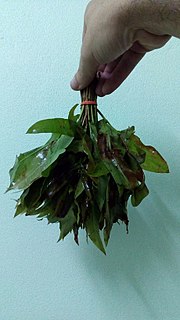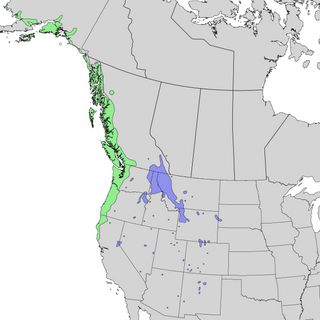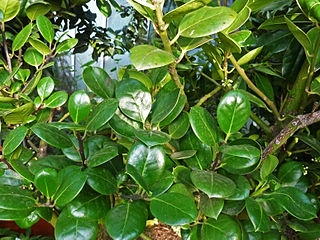
In biological classification, the term subspecies refers to one of two or more populations of a species living in different subdivisions of the species' range and varying from one another by morphological characteristics. A single subspecies cannot be recognized independently: a species is either recognized as having no subspecies at all or at least two, including any that are extinct. The term may be abbreviated to subsp. or ssp. The plural is the same as the singular: subspecies.

Alnus incana, the grey alder or speckled alder, is a species of tree in the birch family, with a wide range across the cooler parts of the Northern Hemisphere.

Leucopogon is a genus of about 150-160 species of shrubs or small trees in the family Ericaceae, in the section of that family formerly treated as the separate family Epacridaceae. They are native to Australia, New Zealand, New Caledonia, the western Pacific Islands and Malaysia, with the greatest species diversity in southeastern Australia. Plants in this genus have leaves with a few more or less parallel veins, and tube-shaped flowers usually with a white beard inside.

Ficus tinctoria, also known as dye fig, or humped fig is a hemiepiphytic tree of genus Ficus. It is also one of the species known as strangler fig.

The Angola colobus, Angolan black-and-white colobus or Angolan colobus, is a primate species of Old World monkey belonging to the genus Colobus.

Pleiospilos is a genus of succulent flowering plants of the family Aizoaceae, native to South Africa. The name is derived from the Greek pleios "many" and spìlos "spot". The plants are also known as kwaggavy, lewerplant, lewervygie, klipplant, split rock or mimicry plant.

Eucalyptus leucoxylon, commonly known as yellow gum, blue gum or white ironbark, is a species of small to medium-sized tree that is endemic to south-eastern continental Australia. It has smooth yellowish bark with some rough bark near the base, lance-shaped or curved adult leaves, flower buds in groups of three and cylindrical, barrel-shaped or shortened spherical fruit. A widely cultivated species, it has white, red or pink flowers.

Protea aurea, the long-bud sugarbush, is a shrub or small tree with a single trunk occurring in mountain fynbos, usually on cool, moist, southern slopes. It is endemic to the Cape Provinces of South Africa.

Montia fontana, commonly known as blinks or water blinks, water chickweed or annual water miner's lettuce, is a herbaceous annual plant of the genus Montia. It is a common plant that can be found in wet environments around the globe, from the tropics to the Arctic. It is quite variable in morphology, taking a variety of forms. It is sometimes aquatic.

Cratoxylum formosum is a species of flowering plant in the Hypericaceae family. Its commercial name in timber production is "mampat".

Eugenia capensis, the dune myrtle, is a species of plant in the family Myrtaceae, which is native to East and southern Africa.

Myristica globosa is a species of plant in the family Myristicaceae. It is found in parts of Melanesia and Australia.

Rhododendron rex (大王杜鹃), the king rhododendron, is a tree species, usually 5–8 m (16–26 ft) in height, in the family Ericaceae. It is found in China, India, and Myanmar, where it is threatened by habitat loss. The flowers are creamy-white, or pale yellow to pink, with a crimson basal blotch. The leaves are 17–27 cm in length and are covered on the underside with an indumentum that ranges in colour from greyish to rusty brown.

Sambucus racemosa subsp. racemosa is a subspecies of Sambucus racemosa, with the common names European red elder and Pacific red elderberry.
Aphanocalyx is a genus of flowering plants in the family Fabaceae. It belongs to the subfamily Detarioideae.
Oxera baladica is a species of flowering plant in the family Lamiaceae. It comprises two subspecies, both of which are included as vulnerable species on the IUCN Red List:

Ficus popenoei is a species of fig found in Latin America, from Brazil and Peru up to Guatemala and Belize.

Ilex perado, the Macaronesian holly, is a species of holly endemic to Macaronesia, distributed throughout the Azores, Madeira and Canary islands. It is an important component of the natural high-altitude Macaronesian rainforest, known as 'laurisilva', found mostly at 500 to 1,200 m altitude but it also appears in forest formations at lower altitudes. Many of the subspecies have been classified as threatened, probably because of very small population sizes, and are protected by local, national and regional legislation.
Cyananthus microphyllus, called the small-leaved bluebell-flower, is a species of flowering plant in the genus Cyananthus, native to the western Himalayas, Nepal, and Tibet. It has gained the Royal Horticultural Society's Award of Garden Merit.

Pleiospilos compactus, called living rock, is a species of flowering plant in the ice plant genus Pleiospilos, native to the southwestern Cape Provinces of South Africa. A succulent, it has gained the Royal Horticultural Society's Award of Garden Merit.

















